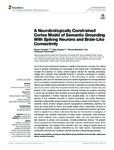A Neurobiologically Constrained Cortex Model of Semantic Grounding With Spiking Neurons and Brain-Like Connectivity
| dc.contributor.author | Tomasello, R | |
| dc.contributor.author | Garagnani, M | |
| dc.contributor.author | Wennekers, Thomas | |
| dc.contributor.author | Pulvermueller, F | |
| dc.date.accessioned | 2019-01-24T12:04:52Z | |
| dc.date.issued | 2018-11-06 | |
| dc.identifier.issn | 1662-5188 | |
| dc.identifier.issn | 1662-5188 | |
| dc.identifier.other | ARTN 88 | |
| dc.identifier.uri | http://hdl.handle.net/10026.1/13220 | |
| dc.description.abstract |
One of the most controversial debates in cognitive neuroscience concerns the cortical locus of semantic knowledge and processing in the human brain. Experimental data revealed the existence of various cortical regions relevant for meaning processing, ranging from semantic hubs generally involved in semantic processing to modality-preferential sensorimotor areas involved in the processing of specific conceptual categories. Why and how the brain uses such complex organization for conceptualization can be investigated using biologically constrained neurocomputational models. Here, we improve pre-existing neurocomputational models of semantics by incorporating spiking neurons and a rich connectivity structure between the model 'areas' to mimic important features of the underlying neural substrate. Semantic learning and symbol grounding in action and perception were simulated by associative learning between co-activated neuron populations in frontal, temporal and occipital areas. As a result of Hebbian learning of the correlation structure of symbol, perception and action information, distributed cell assembly circuits emerged across various cortices of the network. These semantic circuits showed category-specific topographical distributions, reaching into motor and visual areas for action- and visually-related words, respectively. All types of semantic circuits included large numbers of neurons in multimodal connector hub areas, which is explained by cortical connectivity structure and the resultant convergence of phonological and semantic information on these zones. Importantly, these semantic hub areas exhibited some category-specificity, which was less pronounced than that observed in primary and secondary modality-preferential cortices. The present neurocomputational model integrates seemingly divergent experimental results about conceptualization and explains both semantic hubs and category-specific areas as an emergent process causally determined by two major factors: neuroanatomical connectivity structure and correlated neuronal activation during language learning. | |
| dc.format.extent | 88- | |
| dc.format.medium | Electronic-eCollection | |
| dc.language | eng | |
| dc.language.iso | en | |
| dc.publisher | Frontiers Media | |
| dc.subject | word acquisition | |
| dc.subject | semantic grounding | |
| dc.subject | Hebbian learning | |
| dc.subject | distributed neural assemblies | |
| dc.subject | spiking neural network | |
| dc.subject | brain-like connectivity | |
| dc.title | A Neurobiologically Constrained Cortex Model of Semantic Grounding With Spiking Neurons and Brain-Like Connectivity | |
| dc.type | journal-article | |
| dc.type | Journal Article | |
| plymouth.author-url | http://gateway.webofknowledge.com/gateway/Gateway.cgi?GWVersion=2&SrcApp=PARTNER_APP&SrcAuth=LinksAMR&KeyUT=WOS:000449333300001&DestLinkType=FullRecord&DestApp=ALL_WOS&UsrCustomerID=11bb513d99f797142bcfeffcc58ea008 | |
| plymouth.volume | 12 | |
| plymouth.publication-status | Published online | |
| plymouth.journal | Frontiers in Computational Neuroscience | |
| dc.identifier.doi | 10.3389/fncom.2018.00088 | |
| plymouth.organisational-group | /Plymouth | |
| plymouth.organisational-group | /Plymouth/Admin Group - REF | |
| plymouth.organisational-group | /Plymouth/Admin Group - REF/REF Admin Group - FoSE | |
| plymouth.organisational-group | /Plymouth/Faculty of Science and Engineering | |
| plymouth.organisational-group | /Plymouth/Faculty of Science and Engineering/School of Engineering, Computing and Mathematics | |
| plymouth.organisational-group | /Plymouth/REF 2021 Researchers by UoA | |
| plymouth.organisational-group | /Plymouth/REF 2021 Researchers by UoA/UoA11 Computer Science and Informatics | |
| plymouth.organisational-group | /Plymouth/Users by role | |
| plymouth.organisational-group | /Plymouth/Users by role/Academics | |
| dc.publisher.place | Switzerland | |
| dcterms.dateAccepted | 2018-10-15 | |
| dc.rights.embargodate | 2019-1-25 | |
| dc.identifier.eissn | 1662-5188 | |
| dc.rights.embargoperiod | Not known | |
| rioxxterms.funder | EPSRC | |
| rioxxterms.identifier.project | BABEL | |
| rioxxterms.versionofrecord | 10.3389/fncom.2018.00088 | |
| rioxxterms.licenseref.uri | http://www.rioxx.net/licenses/all-rights-reserved | |
| rioxxterms.licenseref.startdate | 2018-11-06 | |
| rioxxterms.type | Journal Article/Review | |
| plymouth.funder | BABEL::EPSRC |


